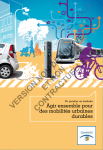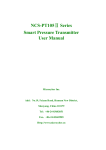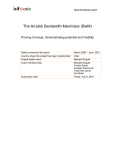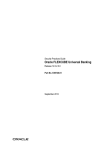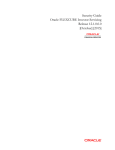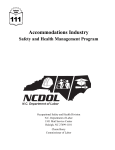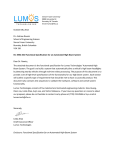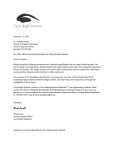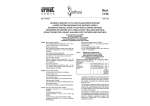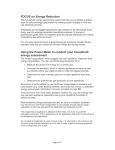Download Jason Coo - Simon Fraser University
Transcript
February 12, 2014 Dr. Andrew Rawicz School of Engineering Science Simon Fraser University Burnaby, British Columbia V5A 1S6 Re: ENSC 305 Functional Specifications for the BikeSmart System Dear Dr. Rawicz: This enclosed is a functional specification for the BikeSmart System. We are designing a smart bike safety system that will allow cyclists to aware the other road users of their next movement without using the existing method, hand signal. In this project, we will equip the bicycle with controller and voice recognition on the helmet to control signal lights. In addition, some other features will be added to the bicycle accordingly. Our functional specification outlines the significant requirements of the system’s functionality. Our team will use this functional specification as their guide through this project to ensure the minimum requirements are met. DreamRide Corporation consists of five talented and innovative fourth year students: Stan Yang, Nadia Tehranchi, Jason Coo, Paul Chen, and Conrad Wang from SFU engineering. Please feel free to contact our CCO via phone: 778-889-2677 or email: [email protected], if you have any question or comment regarding to our functional specification. Sincerely, Jason Coo Jason Coo President and CEO DreamRide Corporation Enclosure: Functional Specification for the BikeSmart System PROJECT TEAM Stan Yang Nadia Tehranchi Jason Coo Paul Chen Conrad Wang CONTACT PERSON Nadia Tehranchi (CCO) [email protected] Function Specification for the BikeSmart System A smart and safe bicycle system SUBMITTED TO Dr. Andrew Rawicz – ENSC 440W Steve Whitmore – ENSC 305W School of Engineering Science ISSUED DATE February 14, 2014 Function Specification for the BikeSmart System Executive Summary Technology nowadays benefits our lives in many ways. Unfortunately, it does not benefit the cyclists as much who are in more danger and risk of death while sharing the road with other road users. Many cyclists are injured or killed every year especially during the rainy season due to losing their controls. When it comes to cycling safety, visibility is the key. The old methods of hand signalling have been used ever since the invention of bicycles. However, the DreamRide Corporation does not think those methods are safe to use while riding a bicycle. Therefore, the DreamRide team came up with an innovative technology for bicyclists in order to feel safer while riding. The BikeSmart System will provide user the safety, comfort, and quality they deserve. The BikeSmart system will have two modes: slide switch control and voice recognition. In the slide switch control mode, the user will be able to control the turn signal and any other added features to the system according to customer’s needs. The additional features can include slope detection system, calories counter, heart rate counter, speed indicator, and many more. In this mode, the slide switch control will be wired. In the voice recognition mode, the turning signal will be controlled by a wireless microphone that is integrated in the helmet. The users will be able to communicate with the system via voice. For instance, by saying “right” or “left” into the microphone, the turning signals will be activated accordingly. Furthermore, our team will confirm that the system meets all the standards and safety guidelines. The team will follow all the requirements in this document. The project will be a span of 4-month of challenging work. The prototype design with its specific features will be ready by April 1, 2014. We believe that our system with its affordable price range can accommodate more than 90% of consumers in the market. Copyright © 2014 DreamRide Corporation. All Rights Reserved. i Function Specification for the BikeSmart System Table of Contents Executive Summary .......................................................................................................................... i Table of Contents .............................................................................................................................ii List of Figures ..................................................................................................................................iii Glossary ...........................................................................................................................................iv 1. Introduction ............................................................................................................................. 1 1.1 Scope ..................................................................................................................................... 1 1.2 Intended Audience ................................................................................................................ 1 1.3 Classification.......................................................................................................................... 1 2. System Requirements .............................................................................................................. 2 2.1 System Overview ................................................................................................................... 2 2.2 General Requirements .......................................................................................................... 3 2.3 Physical Requirements .......................................................................................................... 3 2.4 Electrical Requirements ........................................................................................................ 3 2.5 Environmental Requirements ............................................................................................... 3 2.6 Standards ............................................................................................................................... 3 2.7 Reliability and Durability ....................................................................................................... 4 2.8 Safety Requirements ............................................................................................................. 4 2.9 Usability Requirements ......................................................................................................... 4 3. Voice Recognition Requirements ................................................................................................ 4 3.1 General Requirements .......................................................................................................... 4 3.2 Physical Requirements .......................................................................................................... 4 3.3 Electrical Requirements ........................................................................................................ 4 3.4 Environmental Requirements ............................................................................................... 4 3.5 Usability Requirements ......................................................................................................... 4 4. Slide Switch Requirements ......................................................................................................... 5 4.1 General Requirements .......................................................................................................... 5 4.2 Physical Requirements .......................................................................................................... 5 4.3 Environment Requirements .................................................................................................. 5 4.4 Usability Requirement........................................................................................................... 5 Copyright © 2014 DreamRide Corporation. All Rights Reserved. ii Function Specification for the BikeSmart System 5. LED Panels Requirements ........................................................................................................... 5 5.1 General Requirements .......................................................................................................... 5 5.2 Physical Requirements .......................................................................................................... 5 5.3 Environment Requirements .................................................................................................. 5 6. Sensors Requirements ................................................................................................................ 5 6.1 General Requirements .......................................................................................................... 5 6.2 Physical Requirements .......................................................................................................... 6 6.3 Environment Requirements .................................................................................................. 6 7. Helmet Requirements ................................................................................................................. 6 7.1 General Requirements .......................................................................................................... 6 7.2 Physical Requirements .......................................................................................................... 6 8. User Documentation ................................................................................................................... 6 9. System Test Plan ......................................................................................................................... 6 9.1 Sensor Tests........................................................................................................................... 6 9.2 Slide Switch Controller Tests ................................................................................................. 7 9.3 Voice Recognition Tests ........................................................................................................ 7 9.4 Battery Tests.......................................................................................................................... 7 10. Conclusion ................................................................................................................................. 8 11. References ................................................................................................................................ 9 List of Figures Figure 1: Sysytem overview ............................................................................................................ 2 Copyright © 2014 DreamRide Corporation. All Rights Reserved. iii Function Specification for the BikeSmart System Glossary LED Light Emitting Diode Arduino Open-source electronics prototyping platform for hardware and software usage ICBC Insurance Corporation of British Columbia CSA Canadian Standards Association CVSTB City of Vancouver Street and Traffic Bylaw USB Universal Serial Bus ABS Arylonitrile-butadiene-styrene copolymer Copyright © 2014 DreamRide Corporation. All Rights Reserved. iv Function Specification for the BikeSmart System 1. Introduction The BikeSmart system is a signalling light device that features a voice recognition system, a slide switch control system, and a monitoring system. As a combination, the features will allow better communication between cyclists and other road users as well as reducing the risk of the cyclists losing control when using the traditional hand signalling method. The objective of BikeSmart is to provide cyclists a safe and comfortable riding experience. 1.1 Scope This document details the necessary functional requirements of the BikeSmart system and also underlines the road safety standards in British Columbia. The requirements provided in this document are categorized and ordered by their functional priority. These requirements fully describe the product specifications of proof-of-concept model and the prototype for possible future reproduction. The members of DreamRide will launch a prototype for a series of tests in order to meet the minimum features listed. 1.2 Intended Audience The functional specification is designed by the engineers of DreamRide. The document will be used as a guidebook for the future development and will provide a basis for the technical measurements of the device. The team members shall refer to the requirements when examine the functionalities and design implementation in the testing process. 1.3 Classification The following convention describes the functional requirement: Functional Requirement [ Rn-p ] where R stands for the word requirements, n denotes the functional requirement number and p for the priority of the functional requirements. The priority of the functional requirements p is classified as the following: Priority Level Description A (High) Only applies to the necessary and essential proof-of concept design. B (Med.) Applies to both the proof-of-concept and final production design. C (Low) If time permits, this functionality will be implemented into the final product. Copyright © 2014 DreamRide Corporation. All Rights Reserved. 1 Function Specification for the BikeSmart System 2. System Requirements The general requirements of the BikeSmart system are described in this section. 2.1 System Overview The BikeSmart system is illustrated in the figure below. Figure 1: System overview The BikeSmart system is consisted of two primary features which are designed to control the LED signal lights installed under the bicycle saddle. The first feature is the voice recognition system that detects keywords from the cyclists. After being amplified by the circuit, these analog keywords are then converted into digital inputs allowing the microcontroller to send the correct information to the LED panel. The second feature is the slide switch control system, which is a different method to provide the same functionality. Instead of detecting keywords from the cyclists, it uses a switch mounted onto the handlebar so that the cyclists will be able to select the corresponding LED turn signals by simply sliding the switch. In addition to the above two functionalities, the BikeSmart system will have a monitoring system which is used to display information such as calories burned, current speed, and heart Copyright © 2014 DreamRide Corporation. All Rights Reserved. 2 Function Specification for the BikeSmart System rate to the cyclists. Combining the primary and secondary features, the BikeSmart system will greatly improves cyclists’ biking experience. 2.2 General Requirements [R1-B] [R2-A] [R3-A] [R4-A] BikeSmart system shall not cost more than $700. BikeSmart system shall be intuitive and easy to use. BikeSmart system shall operate in both indoor and outdoor environment. BikeSmart system shall be able to enhance the users’ visibility on the road. 2.3 Physical Requirements [R5-A] [R6-A] [R7-B] [R8-A] [R9-A] All BikeSmart components shall be firmly installed onto the bike and helmet. BikeSmart system shall be durable and robust. BikeSmart system shall not be heavier than 1 kilogram. The design of controller box on the handle bar must be small in size. ABS filament shall be used via 3D printer for the whole system casing. 2.4 Electrical Requirements [R10-A] [R11-B] [R12-B] [R13-A] [R14-C] [R15-C] [R16-B] [R17-A] BikeSmart system shall be powered by internal Li–ion batteries. BikeSmart system shall have a minimum battery life of approximately five hours. The internal Li-ion batteries shall be rechargeable via mini USB. Electric components such as wires and microcontrollers shall be hidden as well as possible. The troubleshooting of the system shall be easily fixed by the user. The battery lifespan should be at least of two to three years. The system will operate normally when there is interference from other devices. All electrical components on the final product must be powered by a single power source in the range of 3.3 – 5V. 2.5 Environmental Requirements [R18-B] [R19-A] [R20-A] [R21-A] BikeSmart system shall operate in temperature range of -20°C to 40°C. BikeSmart system shall operate in normal humidity. BikeSmart system shall operate in quiet and noisy settings. BikeSmart system shall be silent under normal conditions. 2.6 Standards [R22-A] [R23-A] [R24-A] BikeSmart system shall conform to BCMVA section 184 standards. [7] BikeSmart system shall conform to CVSTB section 41 and 60 (A-F) standards. [8] The helmet shall conform to CSA standards. Copyright © 2014 DreamRide Corporation. All Rights Reserved. 3 Function Specification for the BikeSmart System 2.7 Reliability and Durability [R25-A] [R26-A] [R27-A] BikeSmart system shall withstand normal day-to-day usage. BikeSmart system shall not have hardware or software defects. BikeSmart system shall not require maintenance. 2.8 Safety Requirements [R28-A] [R29-A] [R30-A] BikeSmart system shall not cause excessive heat while operating. BikeSmart system shall not have any electric leakage. BikeSmart system shall not cause any harm to the user. 2.9 Usability Requirements [R31-A] BikeSmart system shall be configured before first time of use. 3. Voice Recognition Requirements 3.1 General Requirements [R32-A] [R33-B] [R34-B] [R35-A] BikeSmart system’s signalling control function shall be activated by voice recognition. BikeSmart system’s heart rate counter shall be activated by voice recognition. BikeSmart system’s calorie calculator shall be activated by voice recognition. BikeSmart system’s speed counter shall be activated by voice recognition. 3.2 Physical Requirements [R36-A] [R37-A] [R38-A] The voice recognition microcontroller size shall not exceed 70x55mm. The voice recognition microcontroller shall be installed in the helmet. The voice recognition microphone shall be small and compact. 3.3 Electrical Requirements [R39-A] [R40-A] The voice recognition microphone shall have noise cancelation. The voice recognition microphone shall have a 10x amplifier. 3.4 Environmental Requirements [R41-A] The voice recognition microphone shall pick up user command in both quiet and noisy environment. 3.5 Usability Requirements [R42-A] [R43-A] [R44-A] The voice recognition system shall recognize any person’s voice. The voice recognition system shall recognize any person’s accent. The voice recognition system shall not recognize words that are not in the command library. Copyright © 2014 DreamRide Corporation. All Rights Reserved. 4 Function Specification for the BikeSmart System 4. Slide Switch Requirements 4.1 General Requirements [R45-A] The slide switch controller box shall be installed firmly on the handle bar. 4.2 Physical Requirements [R46-A] [R47-A] The controller box on the handle bar shall not exceed the size of 70x120x40mm. The slide switch shall be easy to slide. 4.3 Environment Requirements [R48-A] The slide switch controller box shall be capable of operating in extreme weather. 4.4 Usability Requirement [R49-A] [R50-A] [R51-A] Sliding left on the switch shall turn on the left turn signal. Sliding right on the switch shall turn on the right turn signal. The sliding switch shall provide feedback in the controller box. 5. LED Panels Requirements 5.1 General Requirements [R52-A] [R53-A] [R54-A] The LEDs shall be bright enough to see from a distance of at least 30 meters away. The direction signal shall be yellow arrows, and brake signal shall be red. The signals shall be easy to understand by other road users. 5.2 Physical Requirements [R55-A] The length of the LED panel shall not exceed the width of the seat. 5.3 Environment Requirements [R56-A] [R57-A] The LED panels shall be waterproofed in case of rainy seasons. The LED panels shall be operate in the temperature range of -40~85 degrees. 6. Sensors Requirements 6.1 General Requirements [R58-A] [R59-A] [R60-A] The sensors shall give accurate measurements. The sensors shall be capable to measure velocity and heart rate. The sensors shall take in account of inclination and gravity when measuring velocity. Copyright © 2014 DreamRide Corporation. All Rights Reserved. 5 Function Specification for the BikeSmart System 6.2 Physical Requirements [R61-A] [R62-A] The sensors shall be integrated with the microcontroller. The sensors shall be small. 6.3 Environment Requirements [R63-A] The sensors shall operate in any weather. 7. Helmet Requirements 7.1 General Requirements [R64-A] [R65-A] The helmet shall be comfortable to wear. The helmet shall meet the CSA standard. 7.2 Physical Requirements [R66-A] [R67-A] The microcontroller in the helmet shall not block any vision. The helmet with the microcontroller shall not exceed 2 kilograms. 8. User Documentation [R68-C] [R69-C] [R70-C] The user manual shall be written in English. The user manual shall be easy to read. The user manual shall be written with the assumption that the audience has minimal technical knowledge. 9. System Test Plan DreamRide Corporation will perform various types of test plans to ensure that the BikeSmart system meets the functional specifications. Tests will be split into subcategories based on the specific feature involved, which includes sensors, slide switch controller, and voice recognition. A battery test will also be completed at the end in order to verify the system as a whole and to ensure that it adhered to it functional requirements. 9.1 Sensor Tests Sensors used in the system include a triple axis accelerometer and a heart rate sensor. A triple axis accelerometer is capable of measuring acceleration along its X, Y, and Z axes. The information is later used to calculate the speed and the calories burnt. To verify that system can accurately measures the speed, the following tests are expected to be implemented: Copyright © 2014 DreamRide Corporation. All Rights Reserved. 6 Function Specification for the BikeSmart System • • Measuring the accuracy of speed given by the sensor with another bike speedometer. Repeat measurement test on different level of inclination. 9.2 Slide Switch Controller Tests The slide switch controller is expected to be installed on the handle bar. Therefore, the test plan for the controller needs to ensure that the slide switch is capable of operating in any extreme weather. It is also expected to give the users some level of feedback, allowing users to know which direction light is currently being used. To verify that the system will meet the above expectations, the following tests are expected to be implemented: • • Slide the switch to both directions to check if the LED panel response accordingly. Repeat experiment in different environments, including rainy and extreme cold conditions. 9.3 Voice Recognition Tests The BikeSmart system should recognize anyone’s voice and accents, as listed on its usability requirements. To verify that the requirements are met, following tests are implemented. These tests include, but are not limited to: • • • Test the voice recognition on a helmet in a noisy environment Repeat the test with different accent Repeat the test with different speech volume 9.4 Battery Tests The BikeSmart system is powered by Li–ion battery. As specified in the electrical requirements, the system should have around five hours of continuous operation. In order to ensure the requirements are met, a repeated signaling process will be done over a five-hour period to verify that the system has enough power to operate over the period. Copyright © 2014 DreamRide Corporation. All Rights Reserved. 7 Function Specification for the BikeSmart System 10. Conclusion This document has outlined all the functional and design requirements for the BikeSmart system. DreamRide Corporation believes that the BikeSmart system will improve cycling experience and reduce accident rate for the cyclists. The functional specification ensures that the BikeSamrt system is reliable, safe, and follows the national standards and regulations. Lower priority features will be implemented if time permits and if all the critical requirements are already met. The development of the system is well underway and is expected to meet the functional requirements outlined above by the target completion date of April 1st, 2014. Copyright © 2014 DreamRide Corporation. All Rights Reserved. 8 Function Specification for the BikeSmart System 11. References [1]. Magraken, E , "Cyclist Fully At Fault For Collission Following Careless Lane Change; No Adverse Inference From Defendant Failing To Tesitfy". Retrieved January, 2014 Available: http://bc-injury-law.com/blog/tag/bicycle-accident [2]. Olsen, L , "ICBC’s tips to keep cyclists safe as crashes peak in B.C.". Retrieved January, 2014 Available: http://www.icbc.com/news/2013may21-02 [3]. Sinoki, K , "Cycling can still be a risky business". Retrieved January, 2014 Available: http://www.canada.com/vancouversun/news/westcoastnews/story.html?id=af676ed5-9893470f-9690-8eeced31cba3 [4]. "Cycling accidents". Retrieved January, 2013 Available: http://www.rospa.com/roadsafety/advice/cycling/info/cycling_accidents_factsheet.pdf [5]. "Reported road casualties Great Britain: annual report 2012". Retrieved January, 2014 Available: https://www.gov.uk/government/publications/reported-road-casualties-greatbritain-annual-report-2012 [6]. "Lithium-Ion Battery Maintenance Guidelines". Retrieved February, 2014 Available: http://canada.newark.com/pdfs/techarticles/tektronix/LIBMG.pdf [7]. "MOTOR VEHICLE ACT ". Retrieved February, 2013 Available: http://www.bclaws.ca/EPLibraries/bclaws_new/document/LOC/freeside/--%20M%20-/46_Motor%20Vehicle%20Act%20RSBC%201996%20c.%20318/00_Act/96318_05.xml#section1 84 [8]. "STREET AND TRAFFIC BY-LAW NO. 2849". Retrieved February, 2014 Available: http://former.vancouver.ca/bylaws/2849c.PDF#page=34 [9]. Loewen , S , "A Refresher on Cycling Laws". RetrievedJanuary , 2013 Available: http://www.travelsmart.ca/en/Life-and-Home/Bike-More/A-Refresher-on-Cycling-Laws.aspx Copyright © 2014 DreamRide Corporation. All Rights Reserved. 9















